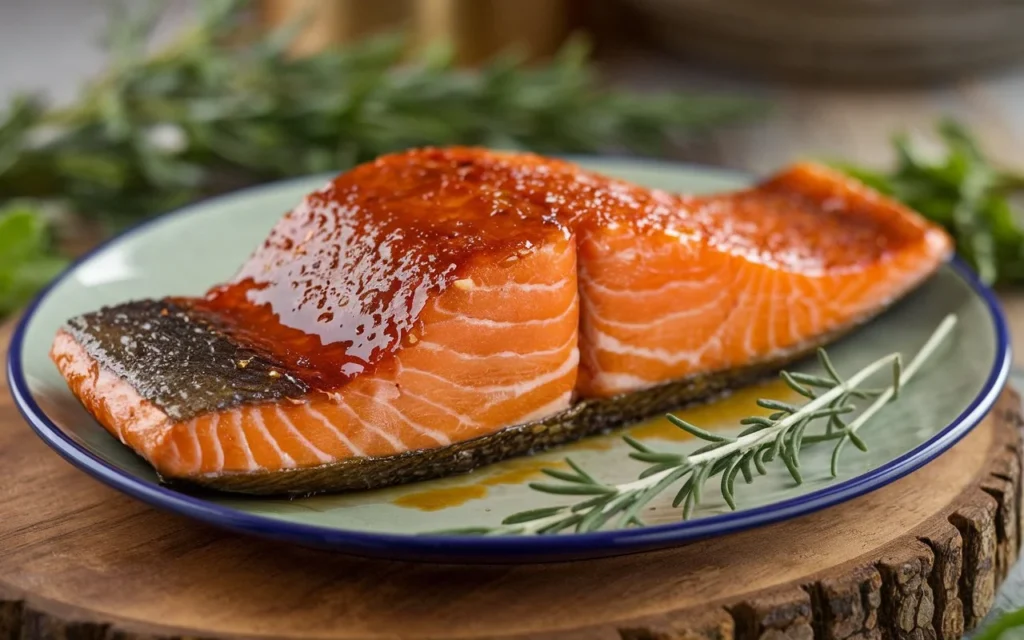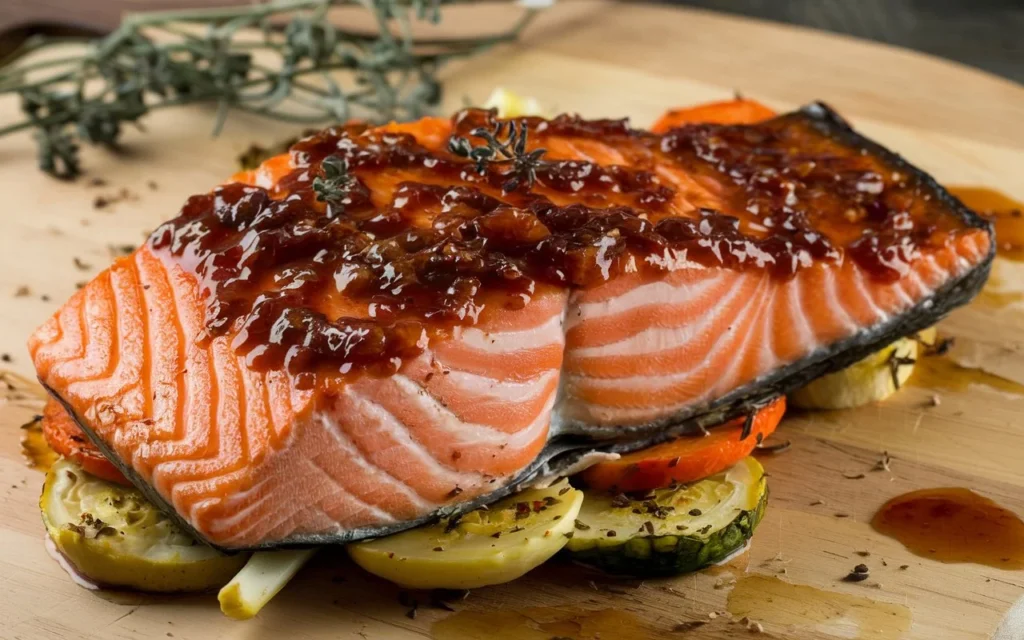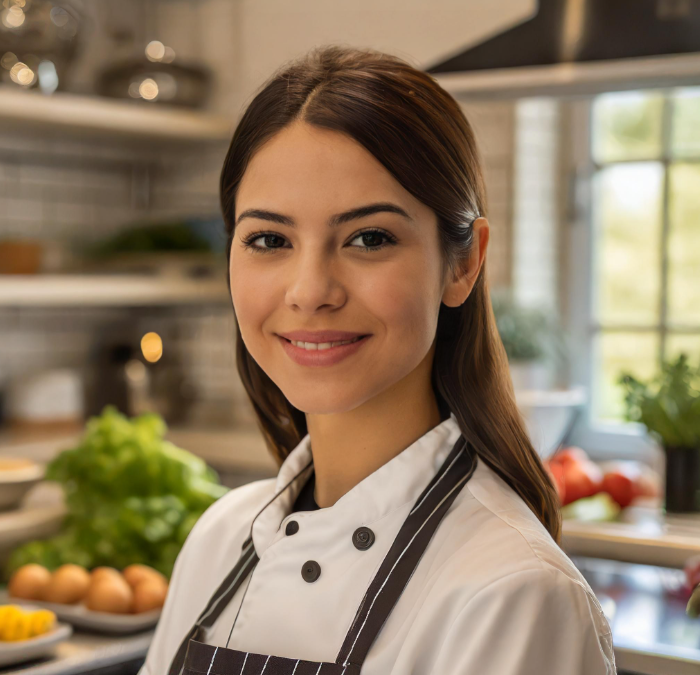Experience the perfect blend of flavors with this glazed salmon recipe, ideal for weeknight dinners or special gatherings. If you’re looking for a dish that’s both healthy and satisfying, glazed salmon is the answer. Not only is salmon rich in Omega-3 fatty acids, but the glaze also brings out a sweet, savory flavor that makes this dish truly irresistible.
Salmon is an incredibly versatile fish that can be baked, grilled, or pan-fried, making it a popular choice for both home cooks and chefs alike. In this article, you’ll discover how to make a mouth-watering glazed salmon recipe that even those who aren’t typically seafood fans will enjoy. Let’s dive in!
Why Glazed Salmon?
Glazed salmon is one of the most beloved seafood dishes around the world, and it’s easy to understand why. The combination of the tender fish and a flavorful glaze creates a symphony of taste and texture that is simply unmatched. Plus, it’s an excellent way to introduce seafood into your diet if you’re not already eating fish regularly.
According to Harvard T.H. Chan School of Public Health, consuming fish rich in Omega-3s can reduce the risk of chronic diseases. In addition, WebMD highlights the role of salmon in promoting heart health, reducing inflammation, and boosting brain function.
Benefits of Eating Salmon
Salmon has numerous health benefits, making it a top choice for a well-balanced meal:
- Rich in Omega-3 Fatty Acids: Salmon is an excellent source of Omega-3 fatty acids, which are essential for cardiovascular health.
- High-Quality Protein: Each serving provides high-quality protein, vital for muscle maintenance and overall health.
- Vitamins and Minerals: Salmon contains significant amounts of vitamins B12 and D, as well as selenium and potassium.
In addition to its health benefits, glazed salmon is quick to prepare and a great option for those hectic weeknights. The glazing process adds an extra layer of flavor, providing a perfect combination of sweetness and umami.
How to Make Glazed Salmon: Step-by-Step Guide
Ingredients You’ll Need
To create the perfect glazed salmon, gather the following ingredients:
- 4 salmon fillets (about 6 oz each)
- 1/4 cup honey
- 2 tablespoons soy sauce
- 1 tablespoon Dijon mustard
- 1 tablespoon lemon juice
- 2 garlic cloves, minced
- 1 teaspoon grated ginger
- Salt and black pepper to taste
- 1 tablespoon olive oil
Instructions for Perfect Glazed Salmon
Follow these simple steps to make this delicious dish:
- Prepare the Glaze: In a small bowl, mix the honey, soy sauce, Dijon mustard, lemon juice, minced garlic, and grated ginger. Whisk until smooth.
- Season the Salmon: Season the salmon fillets with salt and black pepper on both sides.
- Sear the Salmon: Heat a non-stick skillet over medium heat and add the olive oil. Once the oil is hot, place the salmon fillets skin-side down and cook for 3-4 minutes until the skin is crispy.
- Add the Glaze: Flip the salmon fillets and pour the glaze over them. Reduce the heat to low and cook for an additional 5-7 minutes, basting the salmon occasionally with the glaze until it thickens and coats the fish evenly.
- Serve: Remove the salmon from the skillet and serve hot, garnished with fresh herbs like parsley or cilantro.
Tips for the Best Glazed Salmon
- Do Not Overcook: Overcooking can make salmon dry and chewy. Aim for an internal temperature of 125°F for medium-rare doneness.
- Marinate for Extra Flavor: Let the salmon marinate in the glaze for 15-20 minutes before cooking for a deeper flavor.
- Use Fresh Salmon: Fresh salmon will yield the best results, but if using frozen fillets, make sure to thaw them thoroughly.

Perfect Side Dishes for Glazed Salmon
Pairing the right sides can elevate your glazed salmon experience. Here are some ideas:
- Roasted Vegetables: Try roasted asparagus, Brussels sprouts, or carrots for a nutritious complement.
- Garlic Mashed Potatoes: Creamy mashed potatoes are an excellent choice for a comforting and filling meal.
- Quinoa Salad: A light quinoa salad with cucumbers, tomatoes, and feta cheese balances the richness of the salmon.
- Rice Pilaf: A flavorful rice pilaf with herbs and toasted almonds is a perfect match for the sweet and savory glaze.
- Sautéed Spinach: Simple sautéed spinach with garlic and a squeeze of lemon provides a healthy, vibrant side dish.
Variations of Glazed Salmon Recipes
Honey Garlic Glazed Salmon
This variation uses a combination of honey and garlic to create a rich, sticky glaze that coats the salmon beautifully. The sweetness of the honey is balanced by the savory notes of garlic, resulting in a perfect harmony of flavors.
Ingredients:
- 1/4 cup honey
- 4 garlic cloves, minced
- 2 tablespoons soy sauce
- 1 tablespoon apple cider vinegar
- 1/2 teaspoon red pepper flakes (optional)
Instructions:
- Mix the honey, minced garlic, soy sauce, apple cider vinegar, and red pepper flakes in a bowl.
- Season the salmon fillets with salt and pepper.
- Heat a skillet over medium heat, add olive oil, and cook the salmon skin-side down for 3-4 minutes.
- Flip the salmon and add the glaze, cooking for an additional 5-7 minutes while basting.
Maple Dijon Glazed Salmon
Maple syrup and Dijon mustard are a classic combination that provides a balanced sweetness with a tangy kick. This recipe is perfect for those who love a touch of sweetness but also want some depth of flavor.
Ingredients:
- 1/4 cup maple syrup
- 2 tablespoons Dijon mustard
- 1 tablespoon soy sauce
- 1 teaspoon lemon zest
Instructions:
- In a small bowl, mix the maple syrup, Dijon mustard, soy sauce, and lemon zest.
- Season the salmon fillets and sear them in a hot skillet.
- Pour the maple-Dijon glaze over the salmon and let it cook until the glaze thickens and coats the fish.
Teriyaki Glazed Salmon
Teriyaki glaze is a popular choice for salmon, providing a savory-sweet flavor profile that’s incredibly delicious. The combination of soy sauce, brown sugar, and ginger adds a delightful umami element.
Ingredients:
- 1/4 cup soy sauce
- 2 tablespoons brown sugar
- 1 tablespoon rice vinegar
- 1 teaspoon grated ginger
- 1/2 teaspoon sesame oil
Instructions:
- Whisk together the soy sauce, brown sugar, rice vinegar, grated ginger, and sesame oil.
- Cook the salmon in a skillet, then add the teriyaki glaze.
- Continue to cook until the glaze has thickened and coats the salmon.
Health Benefits of Glazed Salmon
In addition to the delicious flavors, glazed salmon offers numerous health benefits that make it a great addition to your diet.
Omega-3 Fatty Acids for Heart Health
Salmon is one of the best sources of Omega-3 fatty acids, which are essential for heart health. These healthy fats help reduce inflammation, lower blood pressure, and improve cholesterol levels. Studies have shown that regular consumption of Omega-3-rich fish like salmon can reduce the risk of cardiovascular disease.
High-Quality Protein for Muscle Maintenance
Salmon is an excellent source of high-quality protein, which is vital for muscle growth and repair. Each serving of salmon provides all the essential amino acids your body needs, making it an ideal choice for those looking to build or maintain muscle mass.
Rich in Essential Vitamins and Minerals
Salmon is packed with essential vitamins and minerals, including vitamin B12, vitamin D, selenium, and potassium. Vitamin B12 is crucial for maintaining healthy nerve and blood cells, while vitamin D supports bone health. Selenium is an antioxidant that helps protect cells from damage, and potassium helps regulate blood pressure.
How to Store and Reheat Glazed Salmon
Storing Leftover Salmon
If you have leftovers, glazed salmon can be stored in an airtight container in the refrigerator for up to 3 days. Make sure the salmon is completely cooled before storing to prevent condensation, which can make it soggy.
Reheating Tips
To reheat glazed salmon without drying it out, follow these steps:
- Oven Method: Preheat your oven to 275°F. Place the salmon on a baking sheet and cover with aluminum foil. Heat for about 15 minutes, or until warmed through.
- Skillet Method: Heat a non-stick skillet over low heat. Add a splash of water or broth to keep the salmon moist, then cover and heat for 5-7 minutes.
- Microwave Method: Place the salmon on a microwave-safe plate and cover with a damp paper towel. Heat on low power in 30-second intervals until warmed through.
More Flavorful Glaze Ideas
Balsamic Glaze
A balsamic glaze adds a tangy and slightly sweet flavor that pairs perfectly with salmon. To make it, simply reduce balsamic vinegar with a bit of honey until it becomes thick and syrupy.
Orange Ginger Glaze
For a citrusy twist, try an orange ginger glaze. Combine fresh orange juice, grated ginger, honey, and a splash of soy sauce for a bright and flavorful glaze that complements the richness of the salmon.
Spicy Sriracha Glaze
If you enjoy a bit of heat, a spicy sriracha glaze is a fantastic option. Mix honey, sriracha sauce, lime juice, and a pinch of garlic powder for a spicy-sweet glaze that will tantalize your taste buds.
Glazed Salmon: Cooking Methods and Techniques
Salmon can be prepared in a variety of ways, each of which brings out different textures and flavors. Here are some popular cooking methods you can use to make glazed salmon:
Baking Glazed Salmon
Baking is a simple and healthy way to cook glazed salmon. Preheat your oven to 375°F and line a baking sheet with parchment paper. Place the seasoned salmon fillets on the baking sheet, and brush them with the prepared glaze. Bake for about 15-20 minutes, or until the internal temperature reaches 125°F. Baking allows the glaze to caramelize slightly, giving the salmon a wonderful depth of flavor.
Grilling Glazed Salmon
Grilling adds a smoky element to glazed salmon that is hard to beat. Preheat your grill to medium-high heat and oil the grates to prevent sticking. Place the salmon fillets on the grill, skin-side down, and brush with the glaze. Grill for 4-5 minutes per side, basting frequently with the glaze to ensure the salmon is well-coated and stays moist. Grilling gives the salmon a slight char that enhances the overall flavor.
Pan-Seared Glazed Salmon
Pan-searing is one of the quickest ways to make glazed salmon. Heat a non-stick skillet over medium-high heat and add a tablespoon of olive oil. Once the oil is hot, place the salmon fillets in the skillet, skin-side down. Cook for 3-4 minutes until the skin becomes crispy. Flip the salmon and add the glaze, cooking for an additional 5-7 minutes while basting continuously. This method results in a beautifully caramelized glaze and crispy skin.
Additional Tips for Cooking Salmon Perfectly
- Room Temperature Salmon: Let the salmon come to room temperature for about 15-20 minutes before cooking. This ensures even cooking throughout the fillet.
- Pat Dry: Use paper towels to pat the salmon fillets dry before seasoning. This helps the skin become crispy when searing or grilling.
- Skin-On Fillets: Cooking salmon with the skin on helps retain moisture. You can remove the skin after cooking if preferred.
Delicious Sauces to Serve with Glazed Salmon
In addition to the glaze, serving a complementary sauce can enhance the flavors of your salmon dish:
Lemon Herb Butter Sauce
A lemon herb butter sauce is a classic pairing for salmon. Melt butter in a saucepan, add minced garlic, lemon juice, and chopped fresh herbs like dill or parsley. Drizzle over the cooked salmon for a rich and zesty finish.
Dill Yogurt Sauce
A light and refreshing dill yogurt sauce is perfect for balancing the richness of glazed salmon. Mix plain Greek yogurt with fresh dill, lemon zest, and a pinch of salt. Serve on the side or spoon over the salmon for a cool contrast.
Mango Salsa

For a tropical twist, serve your glazed salmon with mango salsa. Combine diced mango, red onion, jalapeño, cilantro, and lime juice for a fresh, fruity topping that adds sweetness and acidity to the dish.
Frequently Asked Questions (FAQs)
Can Little Kids Eat Salmon?
Absolutely! Salmon is not only safe but also highly beneficial for children due to its Omega-3 fatty acids, which support brain development. Just ensure that the salmon is thoroughly cooked and free from any small bones.
How to Cook Salmon to Hide the Taste?
If you’re not fond of the fishy taste, a good glaze (like this honey-soy one) can mask it effectively. Additionally, cooking the salmon with plenty of garlic, ginger, or lemon can help minimize the strong flavor.
Can You Poach Salmon?
Yes, poaching is an excellent way to cook salmon if you prefer a lighter taste. Simply simmer the salmon in a mixture of water, lemon slices, and herbs until it’s fully cooked.
How to Eat Canned Salmon?
Canned salmon can be used in a variety of dishes, such as salmon patties, salads, or even pasta. Be sure to drain it well, and remove any skin or bones for the best texture.








